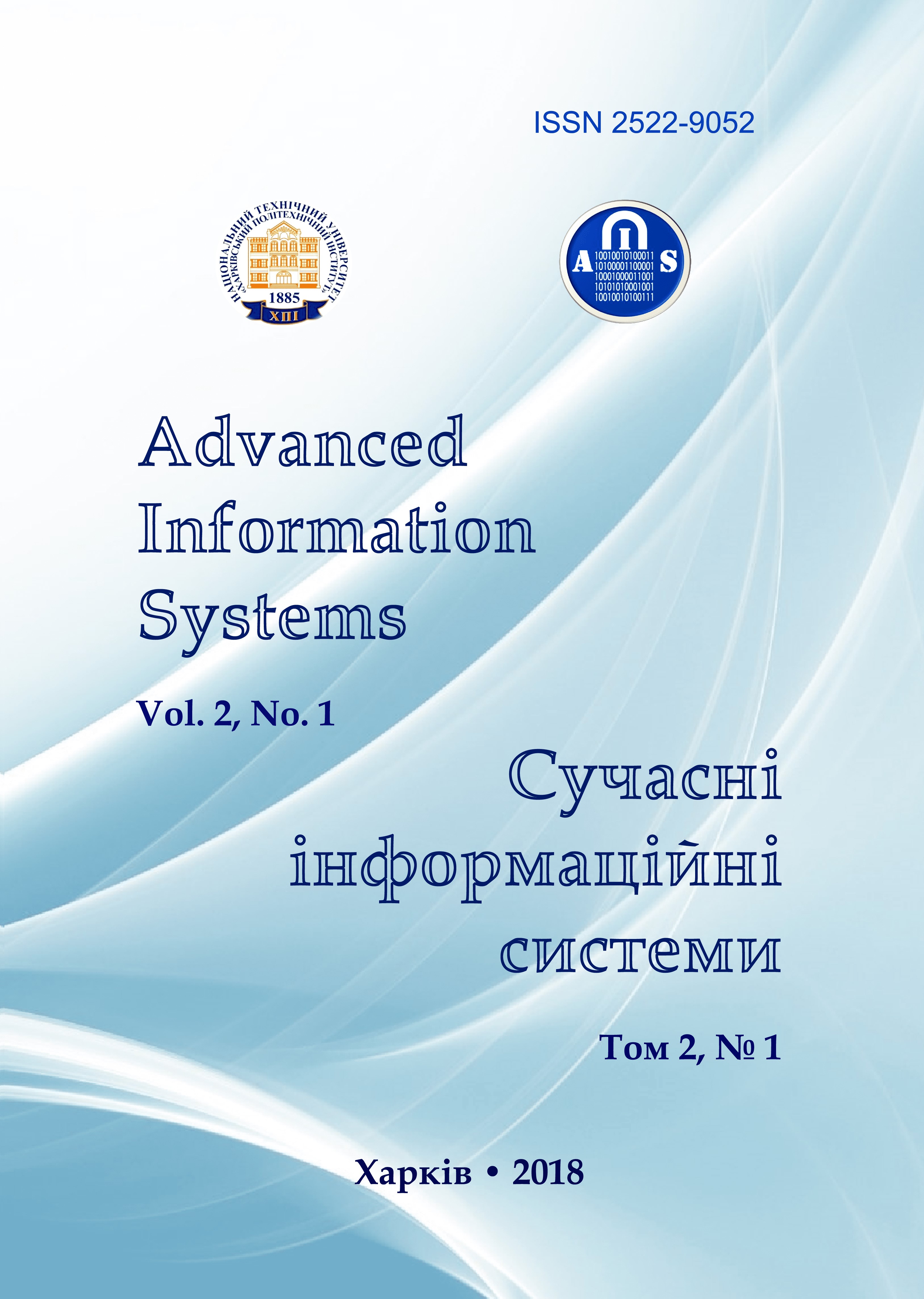METHOD OF SIGNAL PROCESSING IN MIMO SYSTEMS OF UNMANNED AVIATION COMPLEXES
Main Article Content
Abstract
Noise immunity of receiving signals in the MIMO (Multiple Input Multiple-Output) system essentially depends on the choice of the signal processing method on the receiving side. Existing methods of signal processing, in the MIMO system, that provide a given quality of information transmission, have high computational complexity, so there is a necessity to improve these methods. The purpose of this article is to increase the impedance of channels of control and data transmission of unmanned aerial systems, which was achieved by developing new method of signal processing in multi-antenna systems of unmanned aerial systems. The article developed an improved method of signal processing in MIMO systems of unmanned aerial systems, the essence of which is the ability to work with a known and unknown correlation matrix, the division of received signals into groups and the evaluation of each group, taking into account the evaluation error. During the research, the theory of communication, signal theory, the theory of antennas and the theory of noise-proof coding were used. The difference between an improved method is, that the method allows you to work with an unknown correlation matrix. While processing a signal in a demodulator, each iteration takes into account not only the estimate obtained in the previous step, but also the degree of accuracy of the character estimation. The proposed improved method has characteristics, that are close to the characteristics of demodulator, optimal for the criterion of maximum likelihood, but much less computational complexity. The method allows you to reduce computing costs by 20 times, compared with the maximum likelihood algorithm. The practical implementation of this method will allow the creation of software for communication equipment of unmanned aeronautical complexes, which operate in difficult conditions of the radio electronic environment.
Article Details
References
Vishnevskiy, V.M., Lyahov, A.I., Portnoy, S.L. and Shahnovich I.V (2005), Broadband wireless communication networks, Technosphere, Moscow, 592 p.
Malyarchuk, M.V. and Slusar, V.I. (2010), “Perspective communications technology with unmanned aerial vehicles”, Modern information technology in the field of security and defense, NASU, Kyiv, No 1 (7), рр. 47-51.
Slusar, V.I. (2010), “Radio links with UAV: implementation examples.”, Electronics: science, technology, business, No. 5, рр. 56-60.
Serduk, P.E. and Slusar, V.I. (2014), “Communication with terrestrial robotic systems: current state and prospects”, Electronics: science, technology, business, No. 7 (139), рр. 66-79.
Volkov, L.N., Nemirovkiy, M.S. and Shinakov, Yu.S. (2005), Digital radio communication systems: basic methods and characteristics: a tutorial, Eco-Trends, Moscow, 392 p.
Goldsmith, A. (2011), Wireless communications, Technosphere, Moscow, 904 p.
Slusar, V. (2005), “MIMO systems: principles of construction and signal processing”, Electronics: science, technology, business, No. 8, рр. 52-58.
Veselovskiy, K. (2006), Mobile radio communication systems, Hot line Telecom, Moscow, 536 p.
Ehab, M. Shaheen and Mohamed, Samir (2013), “Jamming Impact on the Performance of MIMO Space Time Block Coding Systems over Multi-path Fading Channel”, REV Journal on Electronics and Communications, Vol. 3, No. 1–2, January – June, pр. 68-72.
Zhyvotovskyi, R.M. and Gorobets, Yu.O. (2016), “Analysis of the using of unmanned aviation complexes”, Arms systems and military equipment”, No. 4., pp. 16-21, available at: http://www.hups.mil.gov.ua/periodic-app/article/17317 (last accessed February 3, 2018).
Petruk, S.M. (2017), “Unmanned aviation complexes in armed conflict of the past decades”, Scientific and technical magazine "Armament and military equipment", CRIAME AF of Ukraine, Kyiv, No. 1(13), pp. 44-49.
D. Havronichev, (2011), “Drums UAV USA – present and future”, Military review – site Army herald, available at: http://www.Army-rus-new (last accessed February 3, 2018).
Proceedings of 12th International Conference & Exhibition UAS, Paris, France (2010), available at: http:// www.uas2011.org, (last accessed February 3, 2018).
Ilyshko, V.M., Mitrahovich, M.M., Samkov, A.V., Silkov, V.I., Soloviev O.V. and Strelnikov, V.I. (2009), Unmanned aerial vehicles: Approximate calculation methods of basic parameters and characteristics, CRIAME AF of Ukraine, Kyiv, 302 p.
Pavlushenko, M., Evstafiev, G. and Makarenko I. (2005), Unmanned aerial vehicles: history, application, threat of proliferation and development prospects, Human rights, Moscow, 611 p.
Kobrina, N.V. and Klochko, T.A. (2014), “Application of unmanned aerial systems for solving environmental problems”, Ecology and industry: scientific and production magazine, “UkrSТCEnergostal”, Kharkiv, No. 1 (38), pp. 88-90.
Egorov, K. and Smirnov, S. (2005), “Unmanned aerial systems in armed conflicts”, Military parade, june- august, pp. 34-35.
Unmanned vehicles. Handbook 2010 (2010), Shephard press, Burnham, 145 p.
Slusar, V.I. (2008), “Military communications of NATO countries: problems of modern technologies”, Electronics: science, technology, business, No. 4, pp. 66-71, available at: http://www.electronics.ru/files/article_pdf/0/article_403_181.pdf (last accessed February 3, 2018).
Slusar, V.I. and Masesov, N.A. (2008), “Methods of spatial-temporal signal coding on the basis of the advanced technology of multi-MIMO for stations of tropospheric communication of the Armed Forces of Ukraine”, IV-th scientific and practical conference "Priority areas for the development of telecommunication systems and special purpose networks" (22 – 23 October 2008, reports and abstracts), MITI NТUU "КPІ", Kyiv, pp. 253.
Bessai, H. (2005), MIMO Signals and Systems, Springer science and Business Media, USA, N.-Y., 206 p.
Lee, J., Han, J.K. and Zhang, J. (2009), “MIMO Technologies in 3GPP LTE and LTE-Advanced”, EURASÏP Journal on Wireless Communications and Networking, pp. 1-10.
Kuhzi, V. (2006), Wireless Communications over MIMO Channels. Applications to CDMA and Multiple Antenna Systems, Chichester, U.K., John Wiley Sons, 363 p.
Slusar, V.I. and Masesov, M.O. (2007), “Using of spatial-temporal signal coding methods in the mobile component of communications systems of the Armed Forces of Ukraine”, IV scientific and practical seminar "Priority areas for the development of telecommunication systems and special purpose networks" 22 november 2007 year, MITI NТUU "КPІ", Kyiv, p. 149, available at: http://www.slyusar.kiev.ua/VITI_2007_7.pdf (last accessed February 3, 2018).
Kuvshinov, O.V. and Minochkin, D.A. (2006), “Analysis of the characteristics of radio access systems with MIMO technology”, Collection of scientific works of the Military institute of Taras Shevchenko National University of Kyiv, MIKNU, Kyiv, No. 3, pp. 51-56.
